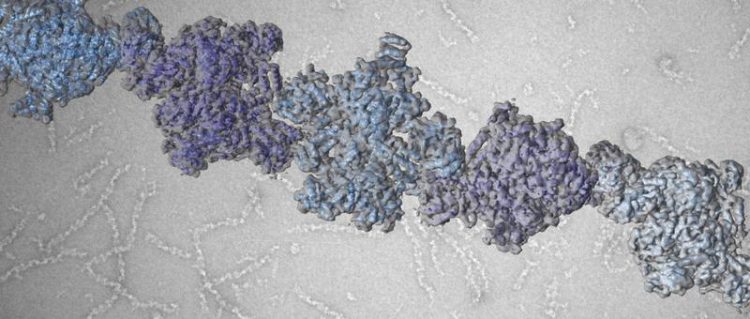Enigma of fatty acid metabolism solved: Enzyme shape controls its activity

ACC filaments regulate enzyme activity and thus control fatty acid production. University of Basel, Biozentrum
Fats are highly diverse molecules that serve as fuel and energy storage, and they constitute the building blocks for cell membranes, hormones and messengers. Despite the diversity of fats, all the fatty acids contained therein arise from the same precursor.
Only a single enzyme initiates its production: acetyl-CoA-carboxylase, ACC for short. ACC is therefore the linchpin of fatty acid synthesis and understanding the architecture of ACC is critical for treating many diseases.
While the enzyme and its function in metabolism have been known for nearly sixty years, scientists have understood very little about the structure of ACC. In fact, modern biochemistry textbooks continue to show old and blurry pictures of filaments formed by ACC, leaving the how and why of filament formation an enigma. Now, a team of researchers led by Prof. Timm Maier from the Biozentrum of the University of Basel has sharpened the picture.
“We have solved this long-standing puzzle in metabolism,” reports Maier. “Elucidating the detailed architectures of ACC filaments revealed their impact on enzymatic activity.”
Pacemaker of fatty acid synthesis
ACC is a key regulator of metabolism and the pacemaker enzyme of fatty acid production. Hence, the regulation of ACC activity is highly complex. Only about half of the ACC enzyme catalyzes chemical reactions while the other half is responsible for controlling ACC activity, acting as a sensor for the demand for ACC products and serving as on-off switch of the enzyme.
Shape of ACC determines its activity
ACC activity is not always the same. Depending on its shape, the activity is high or low. Metabolites signaling an excess of carbohydrates drive the enzyme into its active state. “Dozens of ACC enzymes are linked to form a single filament,” says Maier.
“In this filament, the enzymatic domains are stably arranged to functionally interact with each other. Only then can ACC efficiently catalyze chemical reactions and stimulate fatty acid production. When ACC is not integrated into a filament, the enzymatic domains are flexibly linked and do not collaborate productively.” ACC can also be switched off by filament formation.
Specific control factors force ACC to form inactive filaments, in which the enzymatic domains are strictly separated. This versatile mode of regulation by changing the overall shape of the enzyme is unique and was previously unknown.
ACC as a target structure for drug development
Due to its crucial role in metabolism, ACC is an important target for drug development. Inhibiting ACC activity has the potential to combat cancers or certain viral infections because rapidly proliferating tumor cells and membrane-enveloped viruses require a particularly large amount of fatty acids as membrane components. ACC may also serve as a target for controlling risk factors for developing cardiovascular disease and diabetes linked to aberrant lipid and carbohydrate metabolism, summarized as “metabolic syndrome.” This study opens new possibilities for the development of selective ACC inhibitors that interfere with the activation and filament formation of ACC and ultimately limit fatty acid biosynthesis.
Original source
Moritz Hunkeler, Anna Hagmann, Edward Stuttfeld, Mohamed Chami, Yakir Guri, Henning Stahlberg, Timm Maier
Structural basis for regulation of human acetyl-CoA carboxylase
Nature (2018), doi: 10.1038/s41586-018-0201-4
Further information
Prof. Dr. Timm Maier, University of Basel, Biozentrum, tel. +41 61 207 21 76, email: timm.maier@unibas.ch
Dr. Katrin Bühler, University of Basel, Communications Biozentrum, tel. +41 61 207 09 74, email: katrin.buehler@unibas.ch
Media Contact
More Information:
http://www.unibas.chAll latest news from the category: Life Sciences and Chemistry
Articles and reports from the Life Sciences and chemistry area deal with applied and basic research into modern biology, chemistry and human medicine.
Valuable information can be found on a range of life sciences fields including bacteriology, biochemistry, bionics, bioinformatics, biophysics, biotechnology, genetics, geobotany, human biology, marine biology, microbiology, molecular biology, cellular biology, zoology, bioinorganic chemistry, microchemistry and environmental chemistry.
Newest articles

A ‘language’ for ML models to predict nanopore properties
A large number of 2D materials like graphene can have nanopores – small holes formed by missing atoms through which foreign substances can pass. The properties of these nanopores dictate many…

Clinically validated, wearable ultrasound patch
… for continuous blood pressure monitoring. A team of researchers at the University of California San Diego has developed a new and improved wearable ultrasound patch for continuous and noninvasive…

A new puzzle piece for string theory research
Dr. Ksenia Fedosova from the Cluster of Excellence Mathematics Münster, along with an international research team, has proven a conjecture in string theory that physicists had proposed regarding certain equations….



